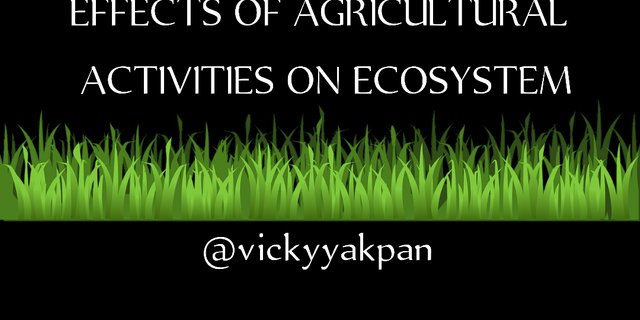
EFFECTS OF AGRICULTURAL ACTIVITIES ON ECOSYSTEM
- Bush burning: Kills organisms in the humus and different beneficial microorganisms which cause decay in the soil. It reduces the natural content of the soil and increases the inorganic content of the soil.
It also exposes the soil to the direct ray of solar and rain.
Tillage: Is vital due to the fact it loosens the soil, will increase the ability of the soil to absorb water, promotes aeration, and prepares a seed bed for crops. The damaging outcomes encompass erosion and flooding.
Fertilizer application: Soil fertility is maintained by using the addition of chemical fertilizers. But excessive use of chemical fertilizers brings about changes in soil pH, soil porosity and aeration as properly as chemical composition of the soil.
Herbicides and pesticides: Pesticides kill the harmful organisms as nicely as the innocent and really useful ones. It also motives pollution of water and land.
Overgrazing: Overgrazing on grasses and shrubs leads to stunted boom of shrubs. Overgrazing also leads to modifications in floristic composition of plant communities and eliminates vegetation on the soil which can lead to erosion.
Farming method: Some farming techniques such as *shifting cultivation and monocropping end result in loss of vegetation, loss of soil fertility and speedy spread of pests and diseases in farms.
Some of the farm methods are:
Shifting cultivation: This is a typical form of farming in which a piece of land is cultivated for about two to four years and then left fallow. This technique of farming is commonly adopted through subsistence farmers. This approach is now not economical, for this reason it results in loss of vegetation.
Monocropping: This approach includes planting of one type of annual crop on a piece of land at a time and harvesting it earlier than some other type of crop is planted on the same piece of land.
Monocropping encourages fast unfold of pests and this results in discount of meals and populace of different animals whose herbal meals is not available.
- Mixed farming: This method deals with elevating of farm animals such as herds and cows and the cultivation of meals and cash vegetation on the identical farm. This method of farming affords crop plant life with the farm yard manure from animals whilst some crop plants are used as meals for animals. Some of these animals serve as capacity of transport. They break or alter the soil shape with their hooves.
Mixed farming makes the unfold of illnesses and pests very challenging given that identical flora are greater extensively separated.
Continous cropping: This is the repeated cultivation of plants in one location of land. It reduces the nutrient contents of the soil.
Pastoral farming: This approach of farming is worried with the rearing or grazing of livestock such as cattle, sheep and goats. The farmer moves from one grazing land to the different (normadic) with his livestock. The Fulanis in West Africa and the Masai in East Africa are well known examples of pastoral farmers. They pass with their farm animals alongside the same routes at precise seasons so that their livestock get desirable grazing land. In this type of farming overgrazing may go away the land naked and expose it to soil erosion.
Crop rotation: This is a method of farming in which the same piece of land is planted with one-of-a-kind crops in successive seasons in order to preserve soil fertility. Deep feeders such as cassava, yam, okro and so on are interchanged with surface feeders such as groundnut, maize etc.
Advantages of crop rotation.
To conserve herbal environment
It allows the manage of pests, diseases and weeds
It keeps soil fertility.
It maintains crop yield
Labour is used an awful lot extra effectively.
Curated by - @juichi
Downvoting a post can decrease pending rewards and make it less visible. Common reasons:
Submit